

Partner Alice B. Toklas, buried together
Queer Places:
850 Beech Ave, Pittsburgh, PA 15233, Stati Uniti
David Bachrach House, 2406-2408 Linden Ave, Baltimore, MD 21217, USA
Harvard University (Ivy League), 2 Kirkland St, Cambridge, MA 02138
215 E Biddle St, Baltimore, MD 21202
Johns Hopkins University, Baltimore, MD 21218, Stati Uniti
20 Bloomsbury Square, Bloomsbury, London WC1A 2NS, UK
27 Rue de Fleurus, 75006 Paris, Francia
5 Rue Christine, 75006 Paris, Francia
Manor House, Bilignin, 01300 Belley, Francia
The Algonquin Hotel Times Square, 59 W 44th St, New York, NY 10036, Stati Uniti
University of Oxford, Oxford, Oxfordshire OX1 3PA
Père Lachaise Cemetery, 16 Rue du Repos, 75020 Paris, Francia
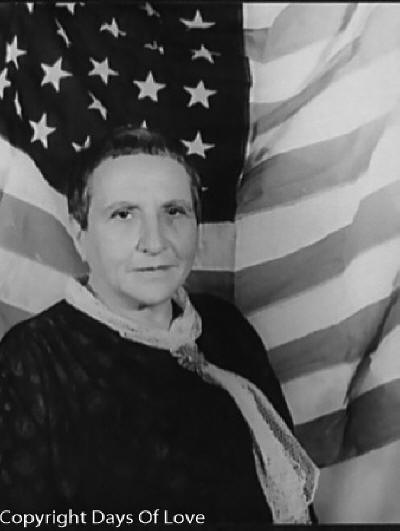 Gertrude
Stein[1] (February 3, 1874 – July 27, 1946) was an American novelist, poet, playwright, and art collector.
Identified with the Lost Generation.
Stein appears as Mrs Percival in Ford Madox
Ford's The Rash Act (1933).
Gertrude
Stein[1] (February 3, 1874 – July 27, 1946) was an American novelist, poet, playwright, and art collector.
Identified with the Lost Generation.
Stein appears as Mrs Percival in Ford Madox
Ford's The Rash Act (1933).
Born in the Allegheny West neighborhood of Pittsburgh, Pennsylvania, and raised in Oakland, California, Stein moved to Paris in 1903, and made France her home for the remainder of her life. She hosted a Paris salon, where the leading figures of modernism in literature and art, such as Pablo Picasso, Ernest Hemingway, F. Scott Fitzgerald, Sinclair Lewis, Ezra Pound, and Henri Matisse, would meet.[2]
American and English novelists such as Gertrude Stein and Bryher, poets suche as Hilda Doolittle, and publishers such as Sylvia Beach all developed different and unique ways of expressing themselves both as lesbians and as exiles in the absence of lesbbian literary and artistic traditions in the decades before the Second World War.
In 1933, Stein published a quasi-memoir of her Paris years, ''The Autobiography of Alice B. Toklas'', written in the voice of her life partner Alice B. Toklas, an American-born member of the Parisian avant-garde. The book became a literary bestseller and vaulted Stein from the relative obscurity of the cult-literature scene into the limelight of mainstream attention.[3] Two quotes from her works have become widely known: "Rose is a rose is a rose is a rose"[4] and "there is no there there", with the latter often taken to be a reference to her childhood home of Oakland, California.
Her books include ''Q.E.D. (Quod Erat Demonstrandum)'' (1903), about a lesbian romantic affair involving several of Stein's female friends, ''Fernhurst'', a fictional story about a romantic affair, ''Three Lives'' (1905–06), and ''The Making of Americans'' (1902–1911). In ''Tender Buttons'' (1914), Stein commented on lesbian sexuality.
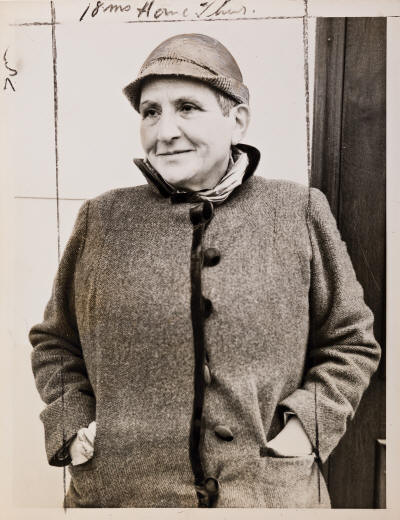
(GERTRUDE STEIN 1874-1946)
A collection of 5 press prints depicting the early LGBTQ+ pioneer and literary figure Gertrude Stein, upon her return to America after decades spent abroad.
Silver press prints, the images measuring 203.2x152.4 to 241.3x184.2 mm.; 8x6 to 9 1/2x7 1/4 inches, the sheets slightly larger, some with editors' retouching marks on recto, each with combinations of hand stamps, notations, and typed caption labels on verso or laid in. 1930s.
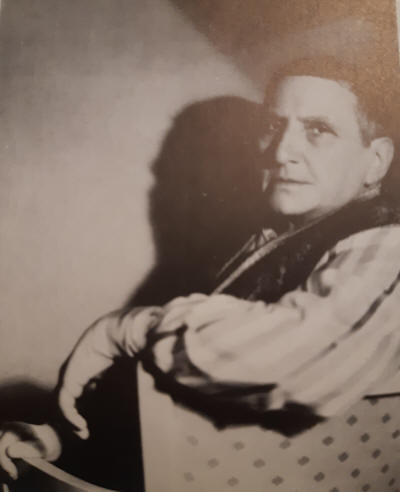
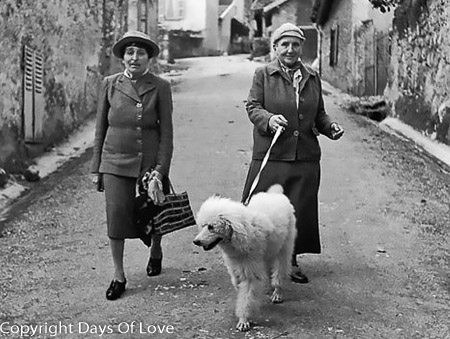
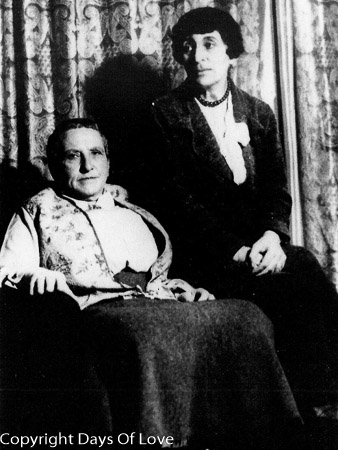
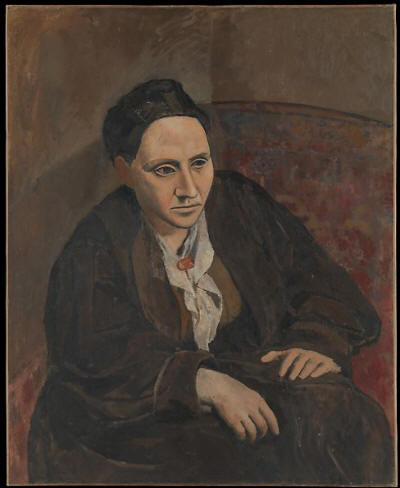
Gertrude Stein, by Pablo Picasso
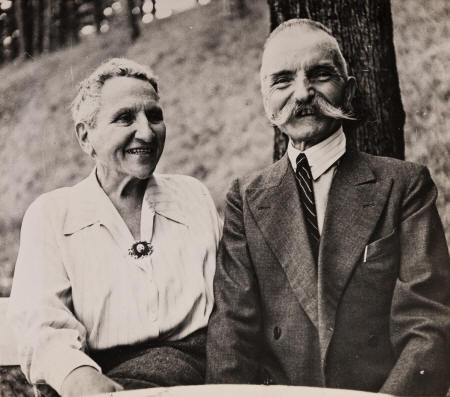
WITH--CARL MYDANS (1938-2002).Gertrude Stein and French Mayor. Silver press print, the image measuring 165.1x193.7 mm.; 6 1/2x7 5/8 inches, the sheet slightly larger, with a typed caption label laid in. 1944.
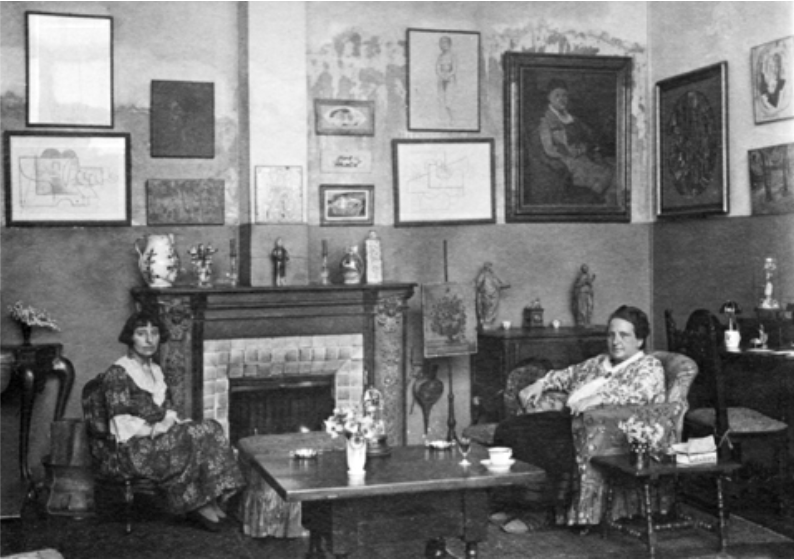
Alice B. Toklas and Gertrude Stein, photographed at home by Man Ray,
with part of their collection of Modernist art, Paris, 1922

Faringdon, February 1937. Gertrude Stein is sitting on the right, opposite Lord Berners. Their partners are sitting on the steps: Robert Hebert-Percy and Alice B. Toklas.
Including Sir Robert and Lady Diane Abdy.
David Bachrach House, 2406-2408 Linden Ave, Baltimore, MD 21217
215 E Biddle St, Baltimore, MD 21202
Historical homosocial and homosexual communities of expatriate American and English women lived in Paris on the Left Bank of the Seine during the opening decades of the twentieth century. The place and time has captured the imaginations of feminist and queer historians, literary critics, art historians, and cultural theorists. These histories of women and their cultural productions are attractive because they demand a rethinking and rewriting of the canonical histories of masculine modernism. The geographical and spiritual locus for these groups were the literary and artistic salons of Natalie Barney and Gertrude Stein, as well as the bookshops and publishing houses owned by Sylvia Beach and Adrienne Monnier. Congregating at these cultural landmarks, Janet Flanner, Colette, Renée Vivien, Djuna Barnes, Hilda Doolittle, Claude Cahun, Marcel Moore (Suzanne Malherbe), Anaïs Nin, and many others invented new ways of living and representing themselves and each other. Martha Vicinus writes: The most striking aspect of the lesbian coteries of the 1910s and 1920s was their self-conscious effort to create a new sexual language for themselves that included not only words but also gestures, costume and behavior. Lillian Faderman notes that these Parisian communities “functioned as a support group for lesbians to permit them to create a self-image which literature and society denied them.”
Stein, the youngest of a family of five children, was born on February 3, 1874, in Allegheny, Pennsylvania (which merged with Pittsburgh in 1907), to upper-middle-class Jewish parents, Daniel and Amelia Stein.[6] [7] Her father was a wealthy businessman with real estate holdings. German and English were spoken in their home.[8]
When Stein was three years old, she and her family moved to Vienna, and then Paris. Accompanied by governesses and tutors, the Steins endeavored to imbue their children with the cultured sensibilities of European history and life.[9] After a year-long sojourn abroad, they returned to America in 1878, settling in Oakland, California, where her father became director of San Francisco's street car lines, the Market Street Railway, in an era when public transportation was a privately owned enterprise.[10] Stein attended First Hebrew Congregation of Oakland's Sabbath school.[11] During their residence in Oakland, they lived for four years on a ten-acre lot, and Stein built many memories of California there. She would often go on excursions with her brother, Leo, with whom she developed a close relationship. Stein found formal schooling in Oakland unstimulating, but she read often: Shakespeare, Wordsworth, Scott, Burns, Smollett, Fielding, and more.
When Stein was 14 years old, her mother died. Three years later, her father died as well. Stein's eldest brother, Michael Stein, then took over the family business holdings and in 1892 arranged for Gertrude and another sister, Bertha, to live with their mother's family in Baltimore.[12] Here she lived with her uncle David Bachrach,[13] who in 1877 had married Gertrude's maternal aunt, Fanny Keyser.
In Baltimore, Stein met Claribel Cone and Etta Cone, who held Saturday evening salons that she would later emulate in Paris. The Cones shared an appreciation for art and conversation about it and modeled a domestic division of labor that Stein would replicate in her relationship with Alice B. Toklas.[14]
Stein attended Radcliffe College, then an annex of Harvard University, from 1893 to 1897 and was a student of psychologist William James. With James's supervision, Stein and another student, Leon Mendez Solomons, performed experiments on ''normal motor automatism'', a phenomenon hypothesized to occur in people when their attention is divided between two simultaneous intelligent activities such as writing and speaking.
These experiments yielded examples of writing that appeared to represent "stream of consciousness", a psychological theory often attributed to James and the style of modernist authors Virginia Woolf and James Joyce. In 1934, behavioral psychologist B.F. Skinner interpreted Stein's difficult poem ''Tender Buttons'' as an example of ''normal motor automatism''.[15] In a letter Stein wrote during the 1930s, she explained that she never accepted the theory of automatic writing: "[T]here can be automatic movements, but not automatic writing. Writing for the normal person is too complicated an activity to be indulged in automatically."[16] She did publish an article in a psychological journal on "spontaneous automatic writing" while at Radcliffe, but "the unconscious and the intuition (even when James himself wrote about them) never concerned her."
At Radcliffe, she began a lifelong friendship with Mabel Foote Weeks, whose correspondence traces much of the progression of Stein's life. In 1897, Stein spent the summer in Woods Hole, Massachusetts, studying embryology at the Marine Biological Laboratory.[17] She received her A.B. (Bachelor of Arts) magna cum laude from Radcliffe in 1898.
While a student at Johns Hopkins and purportedly still naïve about sexual matters, Stein experienced an awakening of her latent sexuality. Sometime in 1899 or 1900, she became infatuated with Mary Bookstaver who was involved in a relationship with a medical student, Mabel Haynes. Witnessing the relationship between the two women served for Stein as her "erotic awakening". The unhappy love triangle demoralized Stein, arguably contributing to her decision to abandon her medical studies. Gertrude completed ''Q.E.D. (Quod Erat Demonstrandum)'' on October 24, 1903.[52] One of the earliest coming out stories,[53] it is about a romantic affair involving Stein and her friends Mabel Haynes, Grace Lounsbury and Mary Bookstaver, and occurred between 1897 and 1901 while she was studying at Johns Hopkins in Baltimore.[54] This story is discussed more completely later in this article in the section on her lesbian relationships.
Leo Stein’s expatriate travels commenced with a summer vacation in 1900 when he traveled throughout Europe with Gertrude and a friend, Mabel Foote Weeks. When Gertrude returned to the states to continue her education, Mabel stayed on in England to study, and Leo remained abroad, resident first in Florence and later in Paris. In 1902 Stein's brother Leo Stein left for London, and Stein followed. In London she became friends with Muriel Draper. The following year the two relocated to Paris, where Leo hoped to pursue an art career.
Leo Stein cultivated important art world connections, enabling the Stein holdings to grow over time. The art historian and collector Bernard Berenson hosted Gertrude and Leo in his English country house in 1902, facilitating their introduction to Paul Cézanne and the dealer Ambroise Vollard.[22] Vollard was heavily involved in the Cézanne art market, and he was the first important contact in the Paris art world for both Leo and Gertrude.
In 1903, Leo decided to take up an artistic career in Paris, and Gertrude, trying to extricate herself from a disastrously unhappy first love affair with an American woman, followed him to 27, rue de Fleurus, where they set up housekeeping. Very soon she displaced her brother as the spokesperson on art and literature, placing herself at the center of the Saturday evenings at home, gathering the men around her while consigning the “wives” to other rooms, where they entertained themselves or were entertained by Alice Toklas. She purposely defined her literary project as separate from Modernism and superior to it; eventually, she accepted as callers to 27, rue de Fleurus, only those who swore absolute loyalty to her, men who agreed to become followers in her literary school.
In March 1904, Stein returned again to America, apparently to try once more to reconcile with May Bookstaver, but the effort was a failure; “when she returned to Europe that summer, sailing with Etta Cone, it represented her last trip to America in thirty years”. As Richard Bridgman notes, it took Gertrude Stein nearly a year and a half after the completion of Q.E.D. to overcome the effects of the affair: “recording it had been insufficient therapy”.
From 1903 until 1914, when they dissolved their common household, Gertrude and her brother Leo shared living quarters near the Luxembourg Garden on the Left Bank of Paris in a two-story apartment (with adjacent studio) located on the interior courtyard at 27 rue de Fleurus, 6th arrondissement. Here they accumulated the works of art that formed a collection that became renowned for its prescience and historical importance.
In the decade between Stein’s arrival in Paris and the onset of World War I, her close friends included Claribel Cone and Etta Cone, Mildred Aldrich, Picasso, Apollinaire, Matisse.
The one time Gertrude Stein appeared at someone else’s salon, she attended an evening in her own honor, arranged by Natalie Barney. An evening at Shakespeare and Company at which Edith Sitwell was asked to honor Stein by reading Stein’s work nearly foundered when Sitwell began reading her own work. By the early 1920s, Stein’s relationship with Shakespeare and Company was severely strained, because Stein could not understand or forgive Sylvia Beach for her support of James Joyce. In the early years when both Stein and Joyce were frequent visitors to the rue de I’Odeon, they managed never to encounter one another. Stein and Toklas stopped visiting the bookshop, transferring their membership to the American Library on the Right Bank when it became known that Beach would publish Joyce’s Ulysses. Later, after Beach broke with Joyce, Stein renewed her friendship with Shakespeare and Company.
In 1904 Stein began ''Fernhurst'', a fictional account of a scandalous three-person romantic affair involving a dean (M. Carey Thomas), a faculty member from Bryn Mawr College (Mary Gwinn) and a Harvard graduate (Alfred Hodder).[55] Mellow asserts that ''Fernhurst'' "is a decidedly minor and awkward piece of writing".[56]
In 1904 Sarah Choate Sears stopped working to care for her ailing husband, and after his death a year later she devoted herself to managing the family’s finances for a brief period. She then traveled throughout Europe with Mary Cassatt and Gertrude Stein, collecting more art and living a highly glamorous lifestyle among artists, musicians and writers.
By early 1906, Leo and Gertrude Stein's studio had many paintings by Henri Manguin, Pierre Bonnard, Pablo Picasso, Paul Cézanne, Pierre-Auguste Renoir, Honoré Daumier, Henri Matisse, and Henri de Toulouse-Lautrec.[32] Their collection was representative of two famous art exhibitions that took place during their residence together in Paris, and to which they contributed, either by lending their art, or by patronizing the featured artists.[33] The Steins' elder brother, Michael, and sister-in-law Sarah (Sally) acquired a large number of Henri Matisse paintings; Gertrude's friends from Baltimore, Claribel Cone and Etta Cone, collected similarly, eventually donating their art collection, virtually intact, to the Baltimore Museum of Art.[34] Sarah Stein was an American art collector. With her husband Michael Stein, the older brother of Leo Stein and Gertrude Stein, she lived in Paris from 1903 to 1935. She supported and popularized the painter Henri Matisse.
After her 1907 graduation, Agnes E. Meyer became one of the first women reporters hired by the New York Sun. A year later, she resumed her literary studies at the Sorbonne where she became friends with Gertrude Stein.
Stein met her life partner Alice B. Toklas[74] on September 8, 1907, on Toklas's first day in Paris, at Sarah and Michael Stein's apartment.[75] Toklas arrived with Harriet Levy, with Toklas maintaining living arrangements with Levy until she moved to 27 Rue de Fleurus in 1910. In an essay written at the time, Stein humorously discussed the complex efforts, involving much letter writing and Victorian niceties, to extricate Levy from Toklas's living arrangements.[78]
In 1908, they summered in Fiesole, Italy, Toklas staying with Harriet Lane Levy, the companion of her trip from the United States, and her housemate until Alice moved in with Stein and Leo in 1910. That summer, Stein stayed with Michael and Sarah Stein, their son Allan, and Leo in a nearby villa. Gertrude and Alice's summer of 1908 is memorialized in images of the two of them in Venice, at the piazza in front of Saint Mark's.
In 1910, Stein met Mabel Dodge, primarily responsible for creating the first interest in Stein’s writing in America at the Armory Show in 1913, this publicity initiating new friendships that included Marsden Hartley, Alfred Stieglitz, Francis Picabia, Carl Van Vechten (whose friendship was to last until Stein’s death), Henry Mcbride, and Juan Gris. By the time Stein and Toklas left France for Spain at the outset of the war, some of these earlier friendships—with Mabel Dodge and Matisse, for instance—had already disintegrated, and the war created a hiatus for all the others.
While living in Paris, Stein began submitting her writing for publication. Her earliest writings were mainly retellings of her college experiences. Her first critically acclaimed publication was ''Three Lives''. In 1911, Mildred Aldrich introduced Stein to Mabel Dodge Luhan and they began a short-lived but fruitful friendship during which the wealthy Mabel Dodge promoted Gertrude's legend in the United States. Mabel was enthusiastic about Stein's sprawling publication ''The Makings of Americans'' and, at a time when Stein had much difficulty selling her writing to publishers, privately published 300 copies of ''Portrait of Mabel Dodge at Villa Curonia''. Dodge was also involved in the publicity and planning of the 69th Regiment Armory Show in 1913, "the first avant-garde art exhibition in America".
Stein and Carl Van Vechten, the noted critic and photographer, became acquainted in Paris in 1913. The two became lifelong friends, devising pet names for each other: Van Vechten was "Papa Woojums", and Stein, "Baby Woojums". Van Vechten served as an enthusiastic champion of Stein's literary work in the United States, in effect becoming her American agent.
After Stein's and Leo's households separated in 1914, she continued to collect examples of Picasso's art, which had turned to Cubism, a style Leo did not appreciate. At her death, Gertrude's remaining collection emphasized the artwork of Picasso and Juan Gris, most of her other pictures having been sold.[39]
New friendships were made with American soldiers—namely, William Rogers—during the war, and when the two women took up their Paris life again in 1918, a new set of alliances was formed. These later friendships included Sylvia Beach and Adrienne Monnier, Sherwood Anderson, Ernest Hemingway, Jacques Lipchitz and Jean Cocteau (both of whom she had known before the war), Jo Davidson, Lincoln Steffens, and Janet Flanner.
In the 1920s she took up a set of younger friends that included Virgil Thomson, Pavel Tchelitchev, Georges Hugnet, René Grevel, and Bravig Imbs, and in the 1930s Francis Rose, Pierre Balmain, and Donald Sutherland.
The gatherings in the Stein home "brought together confluences of talent and thinking that would help define modernism in literature and art". Dedicated attendees included Pablo Picasso, Ernest Hemingway, F. Scott Fitzgerald, Sinclair Lewis, Ezra Pound, Gavin Williamson, Thornton Wilder, Sherwood Anderson, Francis Cyril Rose, Bob Brown, René Crevel, Élisabeth de Gramont, Francis Picabia, Claribel Cone, Mildred Aldrich, Jane Peterson, Carl Van Vechten and Henri Matisse. Saturday evenings had been set as the fixed day and time for formal congregation so Stein could work at her writing uninterrupted by impromptu visitors. It was Stein's partner Alice who became the de facto hostess for the wives and girlfriends of the artists in attendance, who met in a separate room. Janet Flanner was a close friend.
During the summer of 1931, Paul Bowles stayed with them, and Aaron Copland joined him. Stein advised the young composer and writer Paul Bowles to go to Tangier, where she and Alice had vacationed.
Several of Stein's writings have been set to music by composers, including Virgil Thomson's operas ''Four Saints in Three Acts'' and ''The Mother of Us All'', and James Tenney's setting of ''Rose is a rose is a rose is a rose'' as a canon dedicated to Philip Corner, beginning with "a" on an upbeat and continuing so that each repetition shuffles the words, e.g. "a/rose is a rose/is a rose is/a rose is a/rose."
During the 1930s, Stein and Toklas became famous with the 1933 mass market publication of ''The Autobiography of Alice B. Toklas.'' She and Alice had an extended lecture tour in the United States during this decade. They also spent several summers in the town of Bilignin, in the Ain district of eastern France situated in the picturesque region of the Rhône-Alpes. The two women doted on their beloved poodle named "Basket" whose successor, "Basket II", comforted Alice in the years after Gertrude's death.
In the fall of 1934 Elizabeth McCausland and Gertrude Stein met at Hotel Kimbell, Springfield, Mass
In Washington, D.C. Stein was invited to have tea with the President's wife, Eleanor Roosevelt. In Beverly Hills, California, she visited actor and filmmaker Charlie Chaplin who reportedly discussed the future of cinema with her. Stein left America in May 1935, a newly minted American celebrity with a commitment from Random House, who had agreed to become the American publisher for all of her future works.[51] The ''Chicago Daily Tribune'' wrote after Stein's return to Paris: "No writer in years has been so widely discussed, so much caricatured, so passionately championed."
When Stein and Toklas went to England in February 1936 so that Stein could lecture at both Oxford and Cambridge, they stayed with Lord Berners in Berkshire. He wrote a ballet, A Wedding Bouquet, based on Stein’s play, They Must. Be Wedded. To Their Wife. It was given its first performance at Sadler’s Wells on 27 April; the musical director was Constant Lambert, the choreographer Frederick Ashton.
Back in Paris, in November 1937, having to move out of 27 rue de Fleurus, they took a flat at 5 rue Christine. Janet Flanner inventoried their collection of 131 paintings.
Cecil Beaton and Francis Cyril Rose stayed with them in the summer of 1939.
With the outbreak of World War II, Stein and Toklas relocated to a country home that they had rented for many years previously in Bilignin, Ain, in the Rhône-Alpes region. Gertrude and Alice, who were both Jewish, escaped persecution probably because of their friendship to Bernard Fa who was a collaborator with the Vichy regime and had connections to the Gestapo, or possibly because Gertrude was an American and a famous author. Gertrude's book "Wars I Have Seen" written before the German surrender and before the liberation of German concentration camps, likened the German army to Keystone cops. After the war, Stein was visited by many young American soldiers. The August 6, 1945 issue of ''Life'' magazine featured a photo of Stein and American soldiers posing in front of Hitler's bunker in Berchtesgaden. They are all giving the Nazi salute and Stein is wearing the traditional Alpine cap, accompanied by the text: "Off We All Went To See Germany."[85]
In the 1980s, a cabinet in the Yale University Beinecke Library, which had been locked for an indeterminate number of years, was opened and found to contain some 300 love letters written by Stein and Toklas. They were made public for the first time, revealing intimate details of their relationship. Stein's endearment for Toklas was "Baby Precious", in turn Stein was for Toklas, "Mr. Cuddle-Wuddle".[86]
The more affirming essay "Miss Furr and Miss Skeene" is one of the first homosexual revelation stories to be published. The work, like ''Q.E.D.'', is informed by Stein's growing involvement with a homosexual community, though it is based on lesbian partners Maud Hunt Squire and Ethel Mars.[89] The work contains the word "gay" over 100 times, perhaps the first published use of the word "gay" in reference to same-sex relationships and those who have them, and, thus, uninformed readers missed the lesbian content. A similar essay of homosexual men begins more obviously with the line "Sometimes men are kissing" but is less well known.
Author Djuna Barnes provided a caustic assessment of Stein's book, "Wars I Have Seen": "You do not feel that she [Stein] is ever really worried about the sorrows of the people. Her concerns at its highest pitch is a well-fed apprehension."
Stein died on July 27, 1946 at the age of 72 after surgery for stomach cancer at the American Hospital[112] in Neuilly-sur-Seine. She was interred in Paris in Père Lachaise Cemetery.[113] Later Alice B. Toklas was buried alongside her.[114] According to the famous version of her last moments, before having been taken into surgery, Stein asked her partner Toklas: "What is the answer?" After Toklas replied to Stein that there was no answer, Stein countered by sinking back into her bed, murmuring: "Then, there is no question!"[115]
Her companion Toklas, however, has given two other versions of the encounter—neither of which agrees with the "canonical" version above. Writing in the June 2005 edition of ''The New Yorker'', Janet Malcolm describes:
On July 27, 1946, Stein was operated on for what proved to be inoperable stomach cancer and died before coming out of anesthesia. In "What Is Remembered," Toklas wrote of the "troubled, confused and very uncertain" afternoon of the surgery. "I sat next to her and she said to me early in the afternoon, What is the answer? I was silent. In that case, she said, what is the question?" However, in a letter to Van Vechten ten years earlier, Toklas had written: About Baby's last words. She said upon waking from a sleep--What is the question. And I didn't answer thinking she was not completely awakened. Then she said again--What is the question and before I could speak she went on--If there is no question then there is no answer.
Stein's biographers have naturally selected the superior "in that case what is the question?" version. Strong narratives win out over weak ones when no obstacle of factuality stands in their way. What Stein actually said remains unknown. That Toklas cited the lesser version in a letter of 1953 is suggestive but not conclusive.[116] Stein named writer and photographer Carl Van Vechten as her literary executor, and he helped to publish works of hers that remained unpublished at the time of her death. There is a monument to Stein on the Upper Terrace of Bryant Park, New York.
My published books: